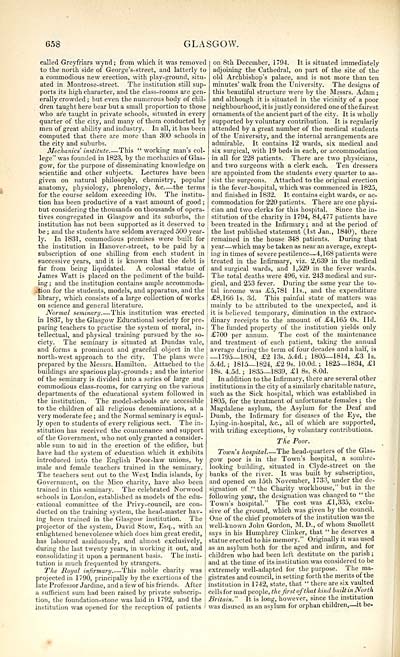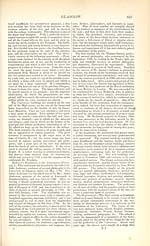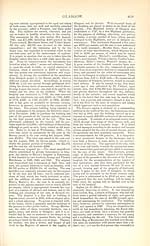Topographical, statistical, and historical gazetteer of Scotland > Volume 1
(756) Page 658
Download files
Complete book:
Individual page:
Thumbnail gallery: Grid view | List view

658
GLASGOW.
called Greyfriars wynd ; from which it was removed
to the north side of George's-street, and latterly to
a commodious new erection, with play-ground, situ-
ated in Montrose-street. The institution still sup-
ports its high character, and the class-rooms are gen-
erally crowded ; but even the numerous body of chil-
dren taught here bear but a small proportion to those
who are taught in private schools, situated in every
quarter of the city, and many of them conducted by
men of great ability and industry. In all, it has been
computed that there are more than 300 schools in
the city and suburbs.
Mechanics' institute. — This " working man's col-
lege" was founded in 1823, by the mechanics of Glas-
gow, for the purpose of disseminating knowledge on
scientific and other subjects. Lectures have been
given on natural philosophy, chemistry, popular
anatomy, physiology, phrenology, &c the terms
for the course seldom exceeding 10s. The institu-
tion has been productive of a vast amount of good ;
but considering the thousands on thousands of opera-
tives congregated in Glasgow and its suburbs, the
institution has not been supported as it deserved to
be ; and the students have seldom averaged 500 year-
ly. In 1831, commodious premises were built for
the institution in Hanover-street, to be paid by a
subscription of one shilling from each student in
successive years, and it is known that the debt is
far from being liquidated. A colossal statue of
James Watt is placed on the pediment of the build-
ing ; and the institution contains ample accommoda-
.tion for the students, models, and apparatus, and the
library, which consists of a large collection of works
on science and general literature.
Normal seminary This institution was erected
in 1837, by the Glasgow Educational society for pre-
paring teachers to practise the system of moral, in-
tellectual, and physical training pursued by the so-
ciety. The seminary is situated at Dundas vale,
and forms a prominent and graceful object in the
north-west approach to the city. The plans were
prepared by the Messrs. Hamilton. Attached to the
buildings are spacious play-grounds ; and the interior
of the seminary is divided into a series of large and
commodious class-rooms, for carrying on the various
departments of the educational system followed in
the institution. The model-schools are accessible
to the children of all religious denominations, at a
very moderate fee ; and the Normal seminary is equal-
ly open to students of every religious sect. The in-
stitution has received the countenance and support
of the Government, who not only granted a consider-
able sum to aid in the erection of the edifice, but
have had the system of education which it exhibits
introduced into the English Poor-law unions, by
male and female teachers trained in the seminary.
The teachers sent out to the West India islands, by
Government, on the Mico charity, have also been
trained in this seminary. The celebrated Norwood
schools in London, established as models of the edu-
cational committee of the Privy-council, are con-
ducted on the training system, the head-master hav-
ing been trained in the Glasgow institution. The
projector of the system, David Stow, Esq., with an
enlightened benevolence which does him great credit,
has laboured assiduously, and almost exclusively,
during the last twenty years, in working it out, and
consolidating it upon a permanent basis. The insti-
tution is much frequented by strangers.
The Royal infirmary This noble charity was
projected in 1790, principally by the exertions of the
late Professor Jardine, and a few of his friends. After j
a sufficient sum had been raised by private subscrip- |
tion, the foundation-stone was laid in 1792, and the i
institution was opened for the reception of patients I
on 8th December, 1794. It is situated immediately
adjoining the Cathedral, on part of the site of the
old Archbishop's palace, and is not more than ten
minutes' walk from the University. The designs of
this beautiful structure were by the Messrs. Adam ;
and although it is situated in the vicinity of a poor
neighbourhood, itis justly considered one of the fairest
ornaments of the ancient part of the city. It is wholly
supported by voluntary contribution. It is regularly
attended by a great number of the medical students
of the University, and the internal arrangements are
admirable. It contains 12 wards, six medical and
six surgical, with 19 beds in each, or accommodation
in all for 228 patients. There are two physicians,
and two surgeons with a clerk each. Ten dressers
are appointed from the students every quarter to as-
sist the surgeons. Attached to the original erection
is the fever-hospital, which was commenced in 1825,
and finished in 1832. It contains eight wards, or ac-
commodation for 220 patients. There are one physi-
cian and two clerks for this hospital. Since the in-
stitution of the charity in 1794, 84,477 patients have
been treated in the Infirmary ; and at the period of
the last published statement (1st Jan., 1840), there
remained in the house 348 patients. During that
year — which may be taken as near an average, except-
ing in times of severe pestilence— 4,168 patients were
treated in the Infirmary, viz. 2,639 in the medical
and surgical wards, and 1,529 in the fever wards.
The total deaths were 496, viz. 243 medical and sur-
gical, and 253 fever. During the same year the to-
tal income was £5,781 lis., and the expenditure
£8,166 Is. 3d. This painful state of matters was
mainly to be attributed to the unexpected, and it
it is believed temporary, diminution in the extraor-
dinary receipts to the amount of £4,165 0s. lid.
The funded property of the institution yields only
£700 per annum. The cost of the maintenance
and treatment of each patient, taking the annual
average during the term of four decades and a half, is
—1795—1804, £2 13s. 5.4d. ; 1805—1814, £3 Is.
5.4d. ; 1815—1824, £2 9s. lO.Od. ; 1825—1834, £1
18s. 4.5d. ; 1835—1839, £1 8s. 8.0d.
In addition to the Infirmary, there are several other
institutions in the city of a similarly charitable nature,
such as the Sick hospital, which was established in
1805, for the treatment of unfortunate females ; the
Magdalene asylum, the Asylum for the Deaf and
Dumb, the Infirmary for diseases of the Eye, the
Lying-in-hospital, &c, all of which are supported,
with trifling exceptions, by voluntary contributions.
The Poor.
Town's hospital. — The head-quarters of the Glas-
gow poor is in the Town's hospital, a sombre-
looking building, situated in Clyde-street on the
banks of the river. It was built by subscription,
and opened on 15th November, 1733, under the de-
signation of " the Charity workhouse," but in the
following year, the designation was changed to " the
Town's hospital." The cost was £1,335, exclu-
sive of the ground, which was given by the council.
One of the chief promoters of the institution was the
well-known John Gordon, M. D., of whom Smollett
says in his Humphrey Clinker, that " he deserves a
statue erected to his memory." Originally it was used
as an asylum both for the aged and infirm, and for
children who had been left destitute on the parish ;
and at the time of its institution was considered to be
extremely well-adapted for the purpose. The ma-
gistrates and council, in setting forth the merits of the
institution in 1742, state, that " there are six vaulted
cells for mad people, the first of that hind built in North
Britain." It is long, however, since the institution
was disused as an asylum for orphan children, — it be-
GLASGOW.
called Greyfriars wynd ; from which it was removed
to the north side of George's-street, and latterly to
a commodious new erection, with play-ground, situ-
ated in Montrose-street. The institution still sup-
ports its high character, and the class-rooms are gen-
erally crowded ; but even the numerous body of chil-
dren taught here bear but a small proportion to those
who are taught in private schools, situated in every
quarter of the city, and many of them conducted by
men of great ability and industry. In all, it has been
computed that there are more than 300 schools in
the city and suburbs.
Mechanics' institute. — This " working man's col-
lege" was founded in 1823, by the mechanics of Glas-
gow, for the purpose of disseminating knowledge on
scientific and other subjects. Lectures have been
given on natural philosophy, chemistry, popular
anatomy, physiology, phrenology, &c the terms
for the course seldom exceeding 10s. The institu-
tion has been productive of a vast amount of good ;
but considering the thousands on thousands of opera-
tives congregated in Glasgow and its suburbs, the
institution has not been supported as it deserved to
be ; and the students have seldom averaged 500 year-
ly. In 1831, commodious premises were built for
the institution in Hanover-street, to be paid by a
subscription of one shilling from each student in
successive years, and it is known that the debt is
far from being liquidated. A colossal statue of
James Watt is placed on the pediment of the build-
ing ; and the institution contains ample accommoda-
.tion for the students, models, and apparatus, and the
library, which consists of a large collection of works
on science and general literature.
Normal seminary This institution was erected
in 1837, by the Glasgow Educational society for pre-
paring teachers to practise the system of moral, in-
tellectual, and physical training pursued by the so-
ciety. The seminary is situated at Dundas vale,
and forms a prominent and graceful object in the
north-west approach to the city. The plans were
prepared by the Messrs. Hamilton. Attached to the
buildings are spacious play-grounds ; and the interior
of the seminary is divided into a series of large and
commodious class-rooms, for carrying on the various
departments of the educational system followed in
the institution. The model-schools are accessible
to the children of all religious denominations, at a
very moderate fee ; and the Normal seminary is equal-
ly open to students of every religious sect. The in-
stitution has received the countenance and support
of the Government, who not only granted a consider-
able sum to aid in the erection of the edifice, but
have had the system of education which it exhibits
introduced into the English Poor-law unions, by
male and female teachers trained in the seminary.
The teachers sent out to the West India islands, by
Government, on the Mico charity, have also been
trained in this seminary. The celebrated Norwood
schools in London, established as models of the edu-
cational committee of the Privy-council, are con-
ducted on the training system, the head-master hav-
ing been trained in the Glasgow institution. The
projector of the system, David Stow, Esq., with an
enlightened benevolence which does him great credit,
has laboured assiduously, and almost exclusively,
during the last twenty years, in working it out, and
consolidating it upon a permanent basis. The insti-
tution is much frequented by strangers.
The Royal infirmary This noble charity was
projected in 1790, principally by the exertions of the
late Professor Jardine, and a few of his friends. After j
a sufficient sum had been raised by private subscrip- |
tion, the foundation-stone was laid in 1792, and the i
institution was opened for the reception of patients I
on 8th December, 1794. It is situated immediately
adjoining the Cathedral, on part of the site of the
old Archbishop's palace, and is not more than ten
minutes' walk from the University. The designs of
this beautiful structure were by the Messrs. Adam ;
and although it is situated in the vicinity of a poor
neighbourhood, itis justly considered one of the fairest
ornaments of the ancient part of the city. It is wholly
supported by voluntary contribution. It is regularly
attended by a great number of the medical students
of the University, and the internal arrangements are
admirable. It contains 12 wards, six medical and
six surgical, with 19 beds in each, or accommodation
in all for 228 patients. There are two physicians,
and two surgeons with a clerk each. Ten dressers
are appointed from the students every quarter to as-
sist the surgeons. Attached to the original erection
is the fever-hospital, which was commenced in 1825,
and finished in 1832. It contains eight wards, or ac-
commodation for 220 patients. There are one physi-
cian and two clerks for this hospital. Since the in-
stitution of the charity in 1794, 84,477 patients have
been treated in the Infirmary ; and at the period of
the last published statement (1st Jan., 1840), there
remained in the house 348 patients. During that
year — which may be taken as near an average, except-
ing in times of severe pestilence— 4,168 patients were
treated in the Infirmary, viz. 2,639 in the medical
and surgical wards, and 1,529 in the fever wards.
The total deaths were 496, viz. 243 medical and sur-
gical, and 253 fever. During the same year the to-
tal income was £5,781 lis., and the expenditure
£8,166 Is. 3d. This painful state of matters was
mainly to be attributed to the unexpected, and it
it is believed temporary, diminution in the extraor-
dinary receipts to the amount of £4,165 0s. lid.
The funded property of the institution yields only
£700 per annum. The cost of the maintenance
and treatment of each patient, taking the annual
average during the term of four decades and a half, is
—1795—1804, £2 13s. 5.4d. ; 1805—1814, £3 Is.
5.4d. ; 1815—1824, £2 9s. lO.Od. ; 1825—1834, £1
18s. 4.5d. ; 1835—1839, £1 8s. 8.0d.
In addition to the Infirmary, there are several other
institutions in the city of a similarly charitable nature,
such as the Sick hospital, which was established in
1805, for the treatment of unfortunate females ; the
Magdalene asylum, the Asylum for the Deaf and
Dumb, the Infirmary for diseases of the Eye, the
Lying-in-hospital, &c, all of which are supported,
with trifling exceptions, by voluntary contributions.
The Poor.
Town's hospital. — The head-quarters of the Glas-
gow poor is in the Town's hospital, a sombre-
looking building, situated in Clyde-street on the
banks of the river. It was built by subscription,
and opened on 15th November, 1733, under the de-
signation of " the Charity workhouse," but in the
following year, the designation was changed to " the
Town's hospital." The cost was £1,335, exclu-
sive of the ground, which was given by the council.
One of the chief promoters of the institution was the
well-known John Gordon, M. D., of whom Smollett
says in his Humphrey Clinker, that " he deserves a
statue erected to his memory." Originally it was used
as an asylum both for the aged and infirm, and for
children who had been left destitute on the parish ;
and at the time of its institution was considered to be
extremely well-adapted for the purpose. The ma-
gistrates and council, in setting forth the merits of the
institution in 1742, state, that " there are six vaulted
cells for mad people, the first of that hind built in North
Britain." It is long, however, since the institution
was disused as an asylum for orphan children, — it be-
Set display mode to: Large image | Transcription
Images and transcriptions on this page, including medium image downloads, may be used under the Creative Commons Attribution 4.0 International Licence unless otherwise stated. ![]()
| Gazetteers of Scotland, 1803-1901 > Topographical, statistical, and historical gazetteer of Scotland > Volume 1 > (756) Page 658 |
|---|
| Permanent URL | https://digital.nls.uk/97446618 |
|---|
| Description | Volume first. A-H. |
|---|---|
| Attribution and copyright: |
|

